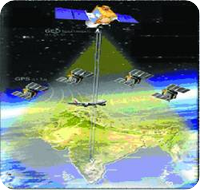Report from Headquarters
Space Foundation Partners Team Up in India
Written by: developer
 GMV, a private, multinational firm headquartered in Madrid, has been awarded a contract with Raytheon to develop a prototype algorithm for India’s new satellite-based civil aviation navigation system.
GMV, a private, multinational firm headquartered in Madrid, has been awarded a contract with Raytheon to develop a prototype algorithm for India’s new satellite-based civil aviation navigation system.
The Global Positioning Satellite-Aided Geosynchronous Augmented Navigation System (GAGAN), which was developed by the Indian Space Research Organization (ISRO) and the Airports Authority of India, will give India the most accurate, flexible, and efficient air navigation system ever deployed. The algorithm GMV is developing will support user receiver data processing for the space-based augmentation system for GAGAN. The program is its final operational phase, incorporating critical navigation components.
This is GMV’s second contract with Raytheon Company. In 2007, GMV began a contract with Raytheon to provide maintenance and training support for Raytheon’s commercial ground systems. Raytheon is a Platinum-level Space Foundation partner and GMV is Patron-level.
Raytheon, which has deployed various elements of the GAGAN system, recently signed a contract with ISRO to incorporate modifications in system data processing, message generation, and user receiver processing to increase the availability of precision approach guidance to civil aircraft. GMV will develop specific elements of the system that relate to user-level mitigation of safety problems that civil aircraft may encounter.
The algorithm GMV is developing will detect ionospheric depletions in the equatorial region for the receiver the operator uses to retrieve and process information provided by the GAGAN ground segment. Because India is located along the equatorial crest, ionospheric effects make it difficult to predict and model navigation. The algorithm will then form part of the user receiver of the GAGAN space-based augmentation system, improving the safety performance for GAGAN users. GMV expects to deliver its portion of the project in June 2010.
This article is part of Space Watch: Februrary 2010 (Volume: 9, Issue: 2).
